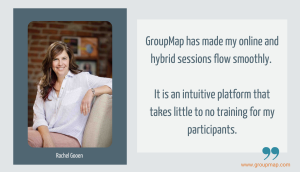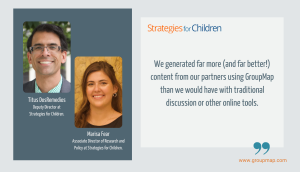
4 Collaborative Activities Using GroupMap In The Classroom.
We all love a good classroom quiz competition. The thrill of competing against others in the classroom using tools such as Kahoot or Socrative adds a level of excitement and urgency. But when it comes time for students to come up with and share their own ideas, we need a different tool. After all, you can’t use a hammer to screw a nail.
Classroom brainstorming, for example, requires students to draw on what they know and to see other perspectives. It’s a great opportunity for them to flex their individuality through divergent, collaborative, and creative thinking. Likewise, developing literacy and comprehension skills, self-awareness and agency require reflective practice.
Using graphic organizers helps you scaffold learning, provides some structure for students to organize their thinking – whether it’s reading a text, planning their work or simply being creative.
PROS of using online graphic organizers
- Being able to create and reuse lesson plan templates without photocopying – saving paper and time.
- Student responses are tracked, moderated, saved, and reportable.
- It helps show the relationship between ideas in an organized way.
- Can quickly share ideas as groups provide feedback directly on student ideas.
- It helps with comprehension, and understanding of meaning and relationships.
CONS of using online graphic organizers
- Limit the students’ writing to whatever content, organization, or style is dictated by the graphic organizer.
- Students need access to technology.
- Traditionally with paper formats, students would only write enough to “fill the space”.
- You need to find the right organizer for the task at hand.
In short, over formatting and regulating a graphic organizer can actually do the reverse of what is intended and limit student independent thinking. At the same time, you still need to have some basic structure to facilitate thinking and discussion.
It makes sense to explore and use a range of context-driven graphic organizers to fit the 21st Century classroom. An online graphic organizer with a tool like GroupMap lets you create a range of graphic organizers so that each student can add their ideas to the template individually or collectively.
We reached out to Ms Jenny Cotham (Masters Education), teacher and community liaison at Winthrop Primary School to share some of the practices she uses both in and out of her classroom. Jenny has used Kahoot and Socrative for creating quizzes along with a myriad of other Edtech tools to enhance her teaching. But when moving to activities beyond Kahoot quizzes, she’s turned to GroupMap.
School Background And Classroom Context
Winthrop Primary is a technology-rich school integrating technology into all curriculum areas. With its 1:1 Device and Bring Your Own Device initiatives, students can participate in class discussions and access learning resources, giving teachers the opportunity to better facilitate class discussion and achieve learning outcomes.

Jenny Cotham is a Primary School Teacher & Community Liaison who teaches middle school students. Her goal is to help teachers design learning opportunities that encourage students to be collaborative, critical thinking and innovative learners.
During the course of the year, Jenny says “ I need to collect and monitor student understanding of learning before, during and after lessons for formative assessment.”
“I want to give each student an opportunity to contribute to a lesson topic and share ideas.” explains Jenny. “Having this done in an organized, scaffolded way would mean saving me time and providing better feedback for each student.”
“I also needed to differentiate and individualize the learning outcome for each student ”She continues. “Outside of the classroom, I wanted a tool that would help gather and organize ideas and feedback from staff meetings, P&C committees, and the School Board so that we have data for decision making.”
Teaching Strategy And Philosophy
Winthrop Primary operates on a Gradual Release of Responsibility instructional framework. Lessons begin by familiarising students with a concept and end with applying understandings and skills independently. GroupMap is used as an online graphic organizer to capture what students think and to facilitate classroom discusssion. It gives each student a voice and keeps them engaged. Teachers can give feedback, facilitate discussion and promote group learning.
Cotham says, “each lesson involves a lot of discussion with students where they can impart and articulate what they understood about the concepts and in turn, learn from each other.” She shares 4 ways she’s used GroupMap as part of her teaching practice and professional life.
1. Graphic Organizers for SMART Goal Setting
Developing a child’s ability to intrinsically set and strive for their own SMART goal (Specific, Measurable, Attainable, Realistic, Timely) is a valuable life long skill.
Kicking off the term, Cotham asks her students to think about a SMART goal they want to set for themselves. This could range from behaviour to learning strategies to knowledge development.

She asks what kind of challenges they think they might face and what support they needed (from her or others). Finally, she asked them to think about how they would measure their success.

Each student enters their own goals in order to create their own printable copy, as well as a digital copy that can be seen by the teacher. “There’s room for individual input without being biased or influenced by what others have said“ Cotham explains.

Goals could be shared semi-anonymously with the whole group. In other words, students can’t see which goals belong to another student, but the teacher can.
As Cotham states, this also helps to “remove bias and the popularity contest. One of the kids the other day wrote that they could help with another person’s goal in GroupMap. They then realized it wasn’t their friend, but that’s not the point. They were to help anyone in the class.”
This allows them to see common goals and to build peer accountability into the classroom. It gives them the big picture and to feel like they are part of a community.

“Going forward, I know which students need help and what kind of help. I can pair up students as needed. I can also ask them to comment on how they are going, and allows me to give me feedback.” explains Cotham.

2. Graphic Organizers For Classroom Brainstorming
What would happen if? That was the question put to students during Science when they had to brainstorm a list of variables that would impact how fast an alka seltzer tablet dissolves. (Rate of chemical reaction).
The activity was described to the class and the question was put to them. Using GroupMap as their graphic organizer, each student pair would add variables that they thought they could change as part of their experiment. This ranged from the type of liquid to the size of the tablet.
With the answers displayed in front of the class, Cotham and her colleague could easily facilitate group learning.
Watch it in action here.
It’s pretty clear that teaching with technology can significantly enhance your lesson plan, make it more engaging for students when they are part of contributing to the class outcomes.
Best of all, there’s a lot less work for the teacher which is a great time saver. Evidence of learning and understanding can be seen immediately and feedback could be given in real-time. Debunking myths and recognizing thinking was a lot easier without production blocks, students being scared to be called out or having to collect all the ideas individually.
3. Graphic organizers for collaborative, fast staff meetings
As part of their ‘Be The Change Project’, Winthrop school aims to integrate a range of sustainability initiatives as part of the school culture.
The challenge was to bring all the staff onto the same page – and to share their current practices, as well as propose new ones. The statement proposed was:
How can we do that effectively so that everyone sees what is happening in the school, gain visibility into current projects and be inspired to create new ones?

GroupMap was for the teachers to share what they were already doing, as well as brainstorm activities around sustainability initiatives, strategies and tactics for the school. This started from a simple list-making exercise that could then be easily grouped into themes.

Cotham then created a brainstorming chart. On the horizontal axis was Local, National and Global to represent the geographic scope. On the vertical axis was the foci of programs such from pure sustainability to a focus on ATSI indigenous Australians.
Grouped ideas and activities could then be positioned across the chart in order to see where the current focus of the staff’s time, energy and resources were going.

Once all the grouped results were positioned, it was easy to visualize current projects in the school. Workload is reduced by identifying projects that could be worked on collaboratively. Opportunities to integrate projects and reduce workload could then be identified.

One of the initiatives explored was the Gardening Project, which teaches students to grow and harvest their own fresh vegetables, fruits and herbs. This helps them understand the food cycle, through to building a sense of community pride as well as getting their hands dirty with nature. They then used this in their own cooking classes and recycle any waste products back to the garden.
A benefit was that all staff instantly see opportunities to collaborate, understand current programs that the school was involved in and then build a sense of school pride.

The outcome, however, was just one benefit. Bringing together a large team of teachers to share their practice is a challenging exercise, let alone getting them to work on the same page. Cotham states “ we are seeing wider school adoption simply because we can use it at our staff meetings as well as the classroom. People get excited to use it and it helps us communicate what is happening a lot easier.”
4. Graphic Organizers For Lesson Planning
Teachers are well versed with the idea of the KWL template. It asks students to share ‘What they know’, ‘What they want to know’, and subsequently What they learned’.
Usually, this is done individually – student by student. This is great but just imagine the power of being able to share the collective wisdom of the group, pair up with research buddies and then reward learning by pointing out interesting facts and learnings.

In this example, Cotham asks students to first share what they already think they know about World War 1. Students are encouraged to “teach” each other based on what they already know. This is done semi-anonymously to avoid reticence.
This is a great way for the teacher to facilitate discussion and give feedback, debunk any myths and to reaffirm current knowledge.

The next step asks them to add ideas about what they would like to learn or find out. This helps to build independent thinking and a sense of inquiry. Giving them more also means they are more engaged in their learning. After all, wouldn’t we all be more interested in something that we were curious about?
Cotham even went a step further to build reflective practice by having students look through the list and pick their top 3 areas of interest. Students could see what other kinds of questions people were asking. Paired research becomes possible because you can group students with common interests together.

It’s heart-warming to see the scope and diversity of questioning that students can come up with when given the opportunity. It creates agency and engagement. Teachers can better focus their time and energy on things that interest the students. They can quickly assess current understanding by harvesting the wisdom of the crowd.
All of these examples show how students move beyond selecting (and sometimes guessing) fixed answers from multiple-choice questions with Apps like Kahoot or Socrative.

Jenny Cotham’s tips for using GroupMap in the classroom
- There are so many options to help save you so much time. GroupMap supports a wide range of activities from student work, and classroom ideas to general brainstorming.
- Use the partially anonymous feature where you want to promote safety in the classroom. Ideas can be added by students without worrying about what their peers might say. But because you can see who said what and provide feedback to the relevant students.
- There are different formats from lists to charts to mind maps. So it’s good to mix up the activities to have a variety of activities.
- There’s definitely scope outside of the classroom. Perfect examples include staff input at Teacher Professional development days, PD workshops, and even board meetings.
- The lock map feature is really handy to stop students from typing and modifying the map. It helps me get their attention back to the front of the class when I need to give instructions for the next steps.



